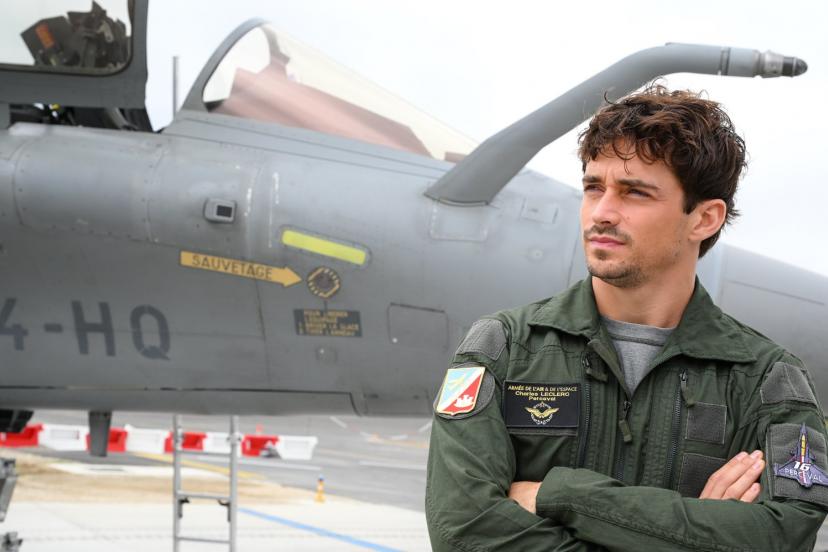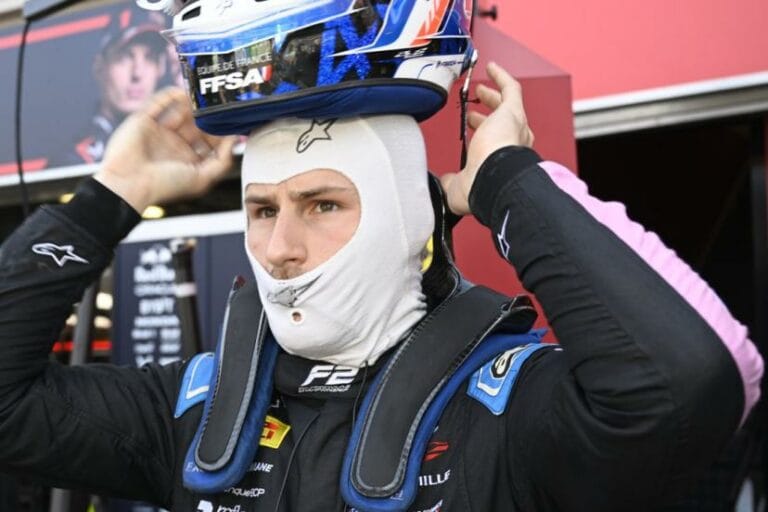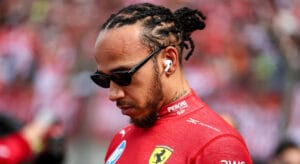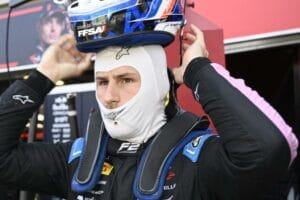How would a Formula 1 driver’s body react in a fighter jet? Charles Leclerc took the challenge over two days, swapping his Ferrari for a Rafale in the French Air Force. L’Équipe accompanied him on his cockpit switch.
From the refuelling plane escorting him, passengers perceive something like a detonation. A dry and powerful boom covers the noise of the A400M’s engine for a fraction of a second. Charles Leclerc heard nothing, as this is routine for fighter pilots, who break the sound barrier without noticing, except by looking at their speed indicator.
Mach 1, or 1,224 km/h, is the Rafale’s speed at this precise moment over the Mediterranean. And it’s also Leclerc’s speed, who took one of the two seats on board that autumn afternoon. The 26-year-old Monegasque is used to dizzying speeds in Formula 1, racing his Ferrari at over 300 km/h in Grand Prix. But nothing compares to that day in the most powerful combat aircraft of the French Air Force, capable of connecting Lille to Marseille in 28 minutes, and incidentally firing 42 shells per second.
What is Leclerc doing in this new seat? It all started with the idea of Lieutenant Sébastien and Captain Valentin, two young officers who are F1 fans and always wanted to fly a car driver, out of love for sport and scientific discovery. The right people had to be put in contact, including Julien Fébreau, the Canal+ journalist, and Charles Leclerc’s profile ended up on the table of the colonel of the 113 military base in Saint-Dizier (Haute-Marne). A Monegasque citizen indeed, but a great friend of France. With certain guarantees at acceleration.
From this challenge was born Perceval, the nickname chosen by Leclerc, like all pilots who use their second military identity to communicate in the air. A reference to his full surname that always has its little effect. The name is inscribed on the visor of the helmet he wears as he climbs into the Rafale, at the dawn of two flying days that are to serve as training for the patrol.
The Ferrari driver arrived there almost from Singapore. Thirty-six hours earlier, he finished fifth in a draining Grand Prix. He left a lot of sweat and lost nearly four kilos, but much more than his body’s mineral salt content needs to be checked before he is allowed to fly. Despite his athlete’s preparation, Leclerc must undergo a medical examination that goes as far as an electrocardiogram.
During the examination, there is a lot of talk about the famous G’s, this force experienced at acceleration responsible for the most significant physiological shocks. Dr. Vincent warns: “A flight in a Rafale is not at all a natural environment for a human being, the experience is demanding. That’s why it’s necessary to eliminate all diseases that can worsen up there. In case of severe discomfort, it will inevitably be ten minutes before care on the ground.”
Experiencing Maranello in the Simulator
As the driver tries on the tight-fitting suit, he recalls a lesson learned in the paddock: “This is like in F1, you have to adjust it well or you’ll sing like Céline Dion.” When he steps into the flight simulator, he feels as if he’s back at Ferrari’s headquarters in Maranello, “Except that there it’s work, here it’s just pleasure.”
At the meeting with Sébastien and Valentin, who will successively direct the two-seater flight, he feels a bit like he’s at a F1 race briefing. The main difference is a piece of advice not found in the roadbooks: “People who don’t feel well, we tell them to look at the horizon. And if you’re really sick, unfasten the mask and do what you have to do.”
Ferrari’s Potential Surprise in the F1 Constructors’ Standings
As he climbs the ladder to slip into the cockpit, Charles Leclerc still has “no apprehension.” Neither about potential airsickness (for precaution, he is equipped with two vomit bags), nor about the risk of fainting that can occur during the most colossal accelerations (his co-pilots have no intention of pushing it that far).
The adventure can begin and Colonel Emmanuel Auzias, who runs the Saint-Dizier base, is curious to witness this “crossing of cultures.” How will a car driver’s body withstand a Rafale? “With their training and the type of acceleration they experience in Formula 1, I think Charles Leclerc will be relatively comfortable,” predicts the commander of BA 113. “Then, it will also be a question of the inner ear. And there, we can’t know in advance.”
Post-Flight Reflections
The answer comes upon landing at the Orange base, after a 3h15 flight. Leclerc needs help to unfasten himself and caution to descend the ladder. But the paleness of his face, above all, suggests that everything did not go as well as in his single-seater. If his emergency bags remained intact, he admits: “I felt sick. These are not movements I’m used to making. It’s really strange.”
The Ferrari driver knows the sensation of being shaken well. But in the car, the most demanding effort is to withstand brief lateral G-forces, up to 5 in the heart of the corners where centrifugal force is exerted, or horizontal ones during heavy braking phases. In the plane, his body is compressed more harshly, for longer, adding verticality, for example during sudden climbs.
The Monegasque was also disoriented by the different spatial references. On the road, his brain understands that he’s moving at high speed. In the air, this was less apparent. “When I’m driving at 270 km/h in Monza, I’m used to having references on the track,” he compares. “But in the sky, in the middle of nowhere, there are zero references. Everything is so far away that I feel like I’m in slow motion, even though I’m experiencing intense G-forces. You realize the thrust, but not the speed.”
The contrast was even more destabilizing as Charles Leclerc‘s body remained ventilated. While he finishes his races in total sweat, this time the pilot benefited from the cockpit’s air conditioning. He felt his heart rate was “super low all the way, maybe 60 beats per minute, no more.” Yet, the effort made him tap into his hydration reserves: “After an hour, I was dry.”
The Black Veil Preceding Fainting
Leclerc had a night to recover. And he needed it before continuing with the return flight. The program included a longer control of the aircraft, one or two supersonic passes, and maneuvers similar to those performed on a mission. The Monegasque himself did not display overflowing optimism about his ability to cope. But upon landing in Saint-Dizier, it was as if a new pilot was born. Fresh and sharp as in a Grand Prix. “I was a bit apprehensive but I was much better, I got used to it.”
He adapted so well that he was able to endure 8.2G, in a machine that can push the most resistant to 9 or 10. He also experienced the black veil that covers the eyes as the body’s limits approach, just before fainting. And he had plenty of opportunity to observe that breaking the sound barrier affects those on the ground more than those in the air. “Supersonic flight is crazy because it’s transparent. It doesn’t change from any other part of the flight.”
Has Leclerc become a fighter pilot? Or would he at least have the means to become one? His instructors think he would have the potential, like other F1 drivers with advanced neurophysiological abilities. “I have no doubt that a Formula 1 driver has developed reflexes, a visual circuit, and an ability to go beyond uncomfortable sensations that would allow him to do the job,” says Lieutenant Sébastien.
Leclerc is not there yet. The eight-time Grand Prix winner plans to stay on the tracks for several more years, even though he realized that a single-seater can be more uncomfortable than a Rafale. “With the bouncing and vibrations, an F1 might be more violent,” he concludes from this extraordinary experience. “In the Rafale, everything is smoother, and you don’t feel the turbulence as much. But when you take the G’s, it’s something.” At Mach 1 as in F1, a pilot rarely has time to dream. Even with his head in the clouds.









